"What is your responsibility to yourself as an artist, integrity, ethics––why are you compelled to make things, and then to whatever community you are in and your artwork is intended for?" These are the questions Dr. Jennifer Awes Freeman asks as she begins a three-year appointment at United as Assistant Professor of Theology and the Arts.
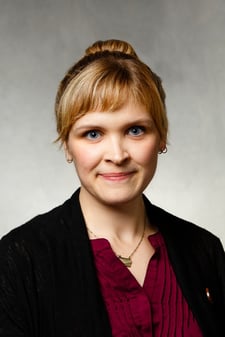 (Jennifer Awes Freeman)
(Jennifer Awes Freeman)
Dr. Freeman was previously Visiting Assistant Professor at the University of St Thomas in 2016-2018 as a postdoctoral fellow at the Louisville Institute. Before that, she completed her doctoral work at Vanderbilt University with her dissertation, “Erasing God: Carolingians, Controversy, and the Ashburnham Pentateuch,” about the study of Trinitarian doctrine and images during the transition from Late Antiquity to the early Middle Ages. Questions of theology and the arts, central to her current research, have always had a place in Freeman's life:
"I have been somebody who draws and paints and been reasonably good at it for as long as I can remember. Even before I encountered religion, since I was raised in nonreligious home, art was how I processed the world." Growing up in Wisconsin, Freeman's introduction to Christianity began with a friend in junior high: "It just kind of clicked, like this is the thing I had been waiting to hear about. I had the sense that there was something else going on in life. And my way of processing this new experience was visual art."
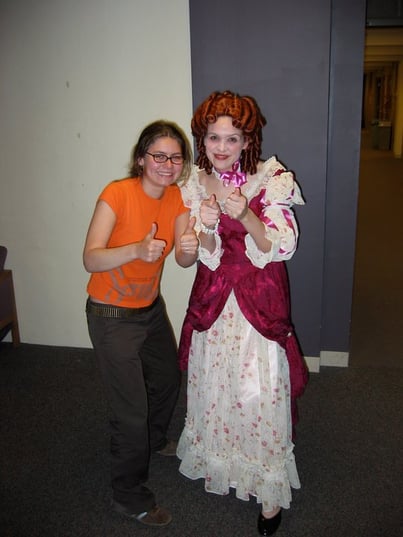 (Dr. Jennifer Awes Freeman in costume for Tartuffe)
(Dr. Jennifer Awes Freeman in costume for Tartuffe)
After high school, Freeman went to college to be a studio artist, where she also got into theatre production. Early on, she developed a connection to medieval iconography and religious art. "I would be working in theatre and I would be painting at night in my apartment, and I would be looking to medieval and Byzantine icons for inspiration. For instance, I did this project that I called the Fast Food Faith series, where I took Byzantine icons and put Ronald McDonald in all of them, you know just trying stuff out!"
After working in theatre in New York, she enrolled at Yale's Institute of Sacred Music. It was in a class on sacred architecture, amidst primarily MDiv. students who had not had her experience with art history. Watching her classmates discover the history of the holy symbols in their own lives, Freeman arrived at certain clarity of purpose: "In the past I was not someone who felt there was something I could do in a ministerial sense. But, here was something I could contribute to the church and the larger community. I can equip future pastors, ministers, community leaders to have some sense of the history they’re a part of––not only to know where you’re coming from, but also so that when you are making choices for your community you are doing it an informed way. And if you want to innovate and do whatever, you can do it in a way that is careful and respectful and informed it can be really exciting."
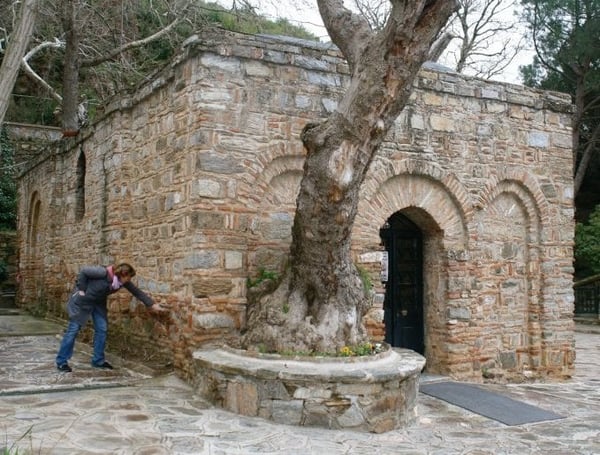 (Mary's house in Ephesus, Turkey)
(Mary's house in Ephesus, Turkey)
It is this mission that has brought Dr. Jennifer Awes Freeman to United. After all, in this particular religious and political climate, the need for historical clarity and reflection is critical for our leaders. "What you are missing when you do not have at least a basic historical grounding is really rich material, rich in the sense that it has a long history and will resonate in communities. Of course some of it will be outdated or be complicated by race or class and need to be revised. But some of the most successful contemporary material spaces don’t eschew or set aside the past but look at it or translate it into a contemporary visual or architectural language."
Asked about the importance of the Middle Ages in particular, Freemon reflects on current events: "At the Charlottesville riots last summer, there were all these images of these white supremacists in their cardboard armor in all their hilarity and horror, and one of them included a fellow who had a shield with a German standard with this black bird, yellow background. A medievalist reposted it with the image of Saint Maurice, who is an African saint and the origin of that standard. I mean, the extreme irony and stupidity of the white supremacist, not understanding that the history of Europe is not a white history. This is one of the things when I teach medieval classes that I try to deal with really explicitly, is that the story of medieval Europe is not the story of ‘white people.’ To use it to harken to a pure white past is false in about a million different ways. Obviously there was oppression and persecution of people. It is not to say that it was a progressive past, but it was a very complicated past, and it was not monolithic."
Freeman will be bringing her medievalist lens into courses like Religious and Theological Interpretation and History of Arts and Theology in Fall and Medieval Women Mystics in Spring. "My favorite line from Moby Dick is 'We agree with Solomon, there’s nothing new under the sun.' That’s my thing. If you think you are doing something cool and sexy, let me show you where it’s already been done in the Middle Ages. This is why I am excited about teaching the Medieval Women Mystics class. There were women who had visions of Jesus as raw meat on a plate, and they ate him. This is stuff contemporary performance artists would like to do, like Lady Gaga but even better! There are things in the past that people should know about, and they can use it to be challenged or be inspired to make new works!"
Along with being a historian, Freeman will approach the Theology and the Arts program as someone who has worked as a professional artist and is excited about the program's emphasis on art-making: "I think everyone should make art. I am a big advocate for everyone drawing. People give up art fourth grade, second grade, when they realize that they have a friend who draws better than them or they realize “what I’m trying to draw here doesn’t reflect the thing in my mind or what I am trying to do.” But a lot of people are bad writers and everybody keeps writing. We need to reclaim drawing as a way of processing our experience. Art is a way of thinking."
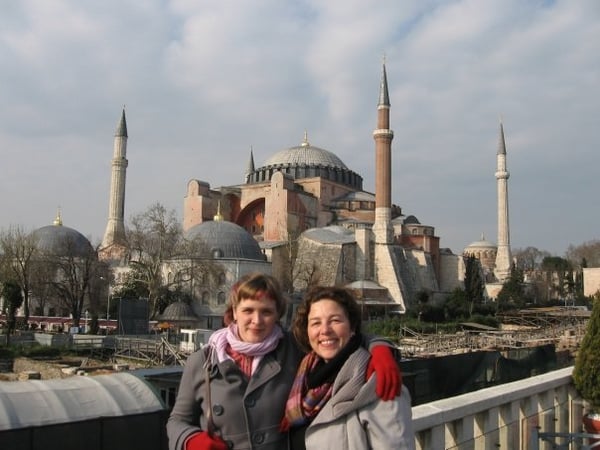 (In Istanbul with friend Judith Dupré)
(In Istanbul with friend Judith Dupré)
At the same time, Freeman challenges us to think more critically about the relationship between artists and religious communities: "In terms of what constitutes a "capital A" Artist and what constitutes religious art, I am concerned. Christian art in particular tends to be of lesser quality or more along the lines of precious moments or something that is emotionally manipulative and I don’t find that to be helpful. If we want to be serious conversation partners with the world we need to edit and figure some of that stuff out. There is a growing divide between the church and art and it shouldn’t be that way. Because of the concerns that both have! Why aren’t they meeting? Why aren’t more churches commissioning artists to do some of that work or to partner in that work?"
For Freeman, there is a concrete immediacy to theology and the arts. "I am not really interested in conversations about beauty in the abstract, not that I won’t have them, but if you are going to talk about beauty I don’t want it to float up into the aether, because we don’t live there. I want to talk about it on the ground and how do we articulate or point to or identify beauty or the grotesque, which for me is the other really important part of beauty. That to me reflects lived experience and that is what resonates more. If we are going to connect to our communities and be relevant, how much is that abstract conversation going to be useful."
Asked about what religious artists, or indeed any artist, can do for their communities, Freeman answers: "One of my intuitions about what an artist does or shouldn't do is they should bring beauty into the world. However, bringing beauty into the world doesn’t mean making something that is saccharine and glazed over and gives you a toothache because there is nothing real in it. An aesthetic beauty is not enough. An artist needs to bring beauty into the world. That can mean a depiction of the grotesque. That can mean something like the AIDS quilt. It means hard stuff. But we do it because of hope for wholeness and peace. Art is an invocation of beauty. Art makes space for beauty. To create art is to create opportunity for serious dialogue."



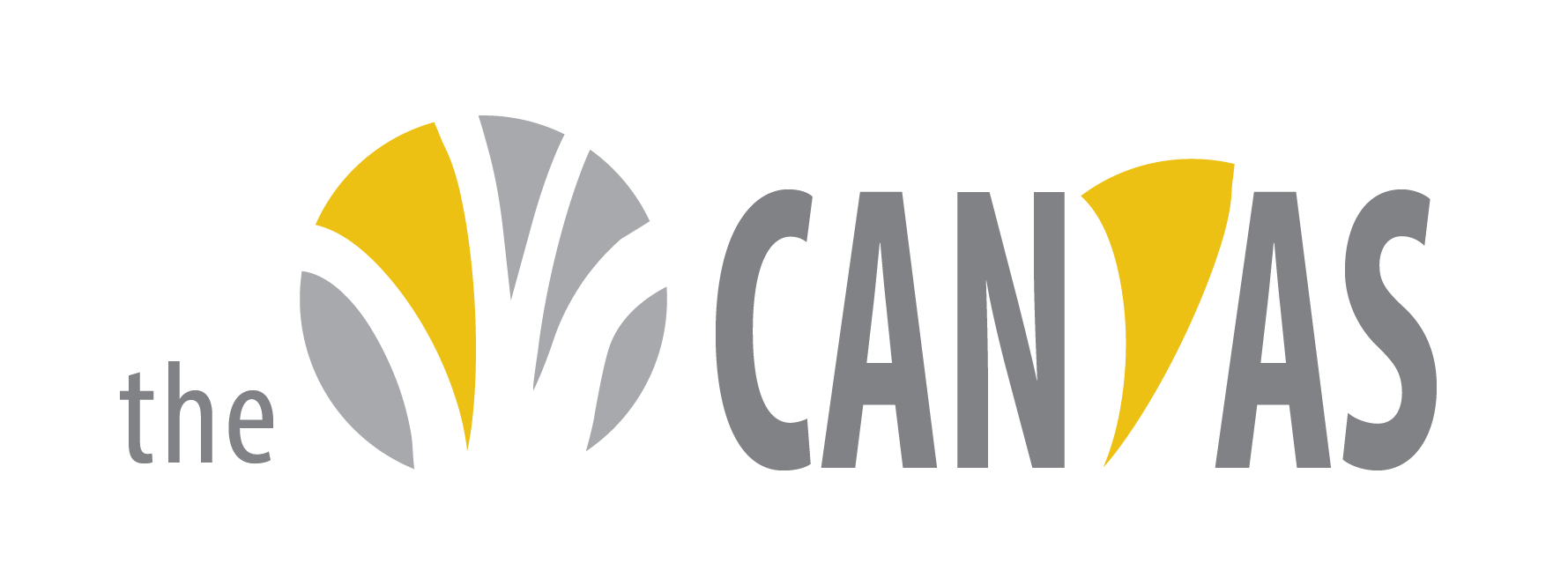
Your Comments :